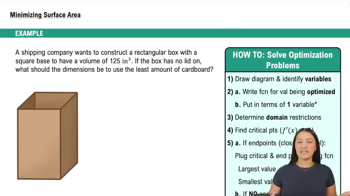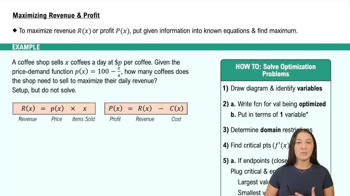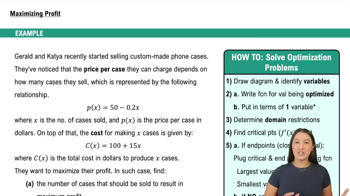Table of contents
- 0. Functions7h 52m
- Introduction to Functions16m
- Piecewise Functions10m
- Properties of Functions9m
- Common Functions1h 8m
- Transformations5m
- Combining Functions27m
- Exponent rules32m
- Exponential Functions28m
- Logarithmic Functions24m
- Properties of Logarithms34m
- Exponential & Logarithmic Equations35m
- Introduction to Trigonometric Functions38m
- Graphs of Trigonometric Functions44m
- Trigonometric Identities47m
- Inverse Trigonometric Functions48m
- 1. Limits and Continuity2h 2m
- 2. Intro to Derivatives1h 33m
- 3. Techniques of Differentiation3h 18m
- 4. Applications of Derivatives2h 38m
- 5. Graphical Applications of Derivatives6h 2m
- 6. Derivatives of Inverse, Exponential, & Logarithmic Functions2h 37m
- 7. Antiderivatives & Indefinite Integrals1h 26m
- 8. Definite Integrals4h 44m
- 9. Graphical Applications of Integrals2h 27m
- 10. Physics Applications of Integrals 2h 22m
5. Graphical Applications of Derivatives
Applied Optimization
Problem 4.5.35.a
Textbook Question
Optimal soda can
a. Classical problem Find the radius and height of a cylindrical soda can with a volume of 354 cm³ that minimize the surface area.
 Verified step by step guidance
Verified step by step guidance1
Start by identifying the formulas involved: The volume of a cylinder is given by \( V = \pi r^2 h \) and the surface area is given by \( A = 2\pi r^2 + 2\pi rh \).
Given that the volume \( V = 354 \text{ cm}^3 \), express the height \( h \) in terms of the radius \( r \) using the volume formula: \( h = \frac{354}{\pi r^2} \).
Substitute \( h \) from the volume equation into the surface area formula to express the surface area \( A \) solely in terms of \( r \): \( A = 2\pi r^2 + \frac{708}{r} \).
To find the radius that minimizes the surface area, take the derivative of \( A \) with respect to \( r \), set it equal to zero, and solve for \( r \). This involves finding \( \frac{dA}{dr} = 4\pi r - \frac{708}{r^2} \) and setting \( \frac{dA}{dr} = 0 \).
Solve the equation \( 4\pi r - \frac{708}{r^2} = 0 \) to find the critical points. Then, use the second derivative test or analyze the behavior of \( \frac{dA}{dr} \) to confirm that the solution gives a minimum surface area. Finally, use the value of \( r \) to find \( h \) using the expression \( h = \frac{354}{\pi r^2} \).
 Verified video answer for a similar problem:
Verified video answer for a similar problem:This video solution was recommended by our tutors as helpful for the problem above
Video duration:
8mPlay a video:
Was this helpful?
Key Concepts
Here are the essential concepts you must grasp in order to answer the question correctly.
Volume of a Cylinder
The volume of a cylinder is calculated using the formula V = πr²h, where r is the radius and h is the height. In this problem, the volume is given as 354 cm³, which serves as a constraint for determining the optimal dimensions of the can.
Recommended video:

Example 5: Packaging Design
Surface Area of a Cylinder
The surface area of a cylinder is given by the formula A = 2πr² + 2πrh, where the first term accounts for the areas of the two circular bases and the second term accounts for the lateral surface area. Minimizing this surface area while maintaining a fixed volume is the core objective of the problem.
Recommended video:

Example 1: Minimizing Surface Area
Optimization Techniques
Optimization in calculus involves finding the maximum or minimum values of a function. In this case, techniques such as setting up a function for surface area in terms of one variable (using the volume constraint) and applying derivatives to find critical points are essential for solving the problem.
Recommended video:

Intro to Applied Optimization: Maximizing Area

 1:13m
1:13mWatch next
Master Intro to Applied Optimization: Maximizing Area with a bite sized video explanation from Callie
Start learningRelated Videos
Related Practice






